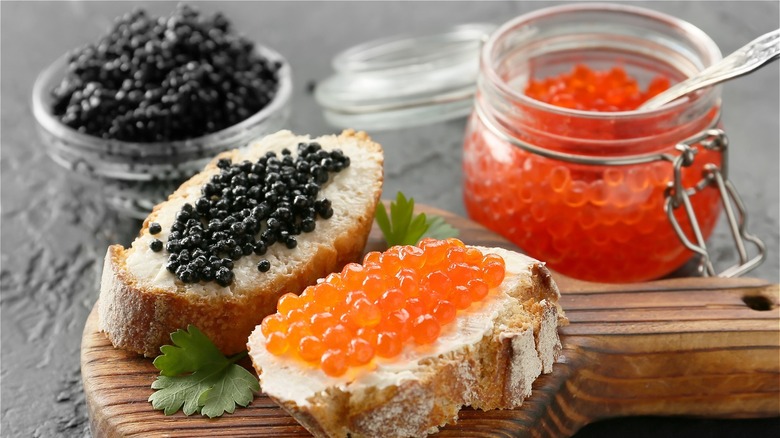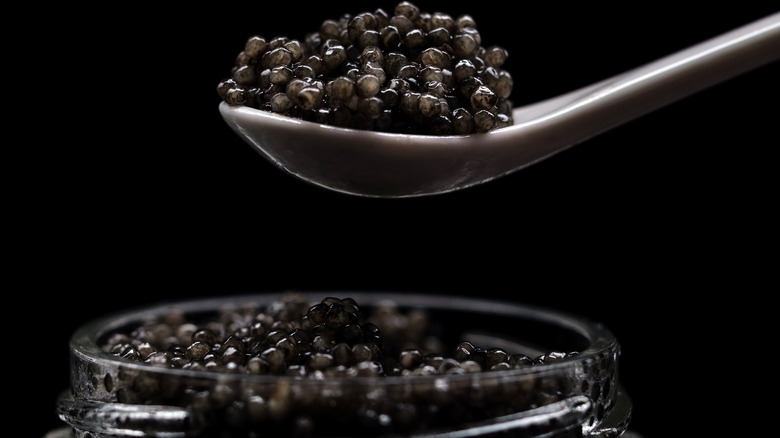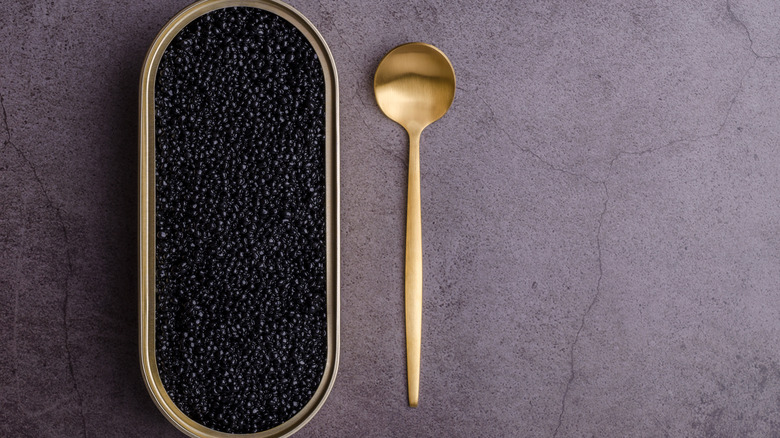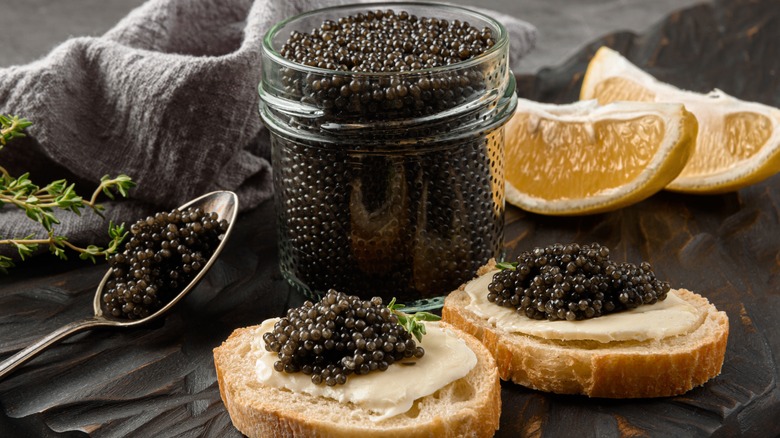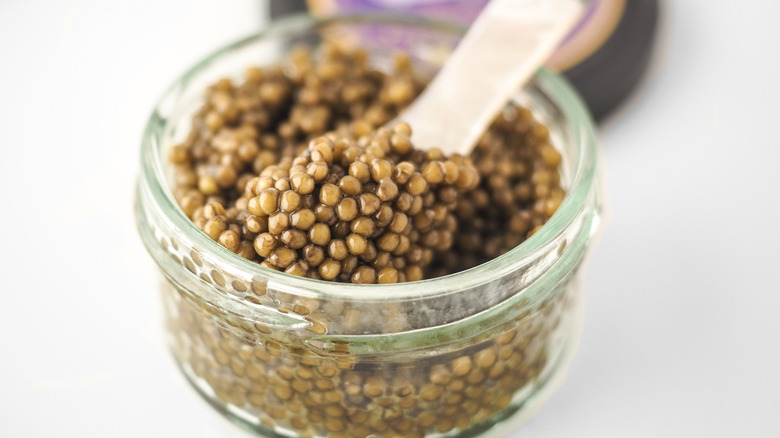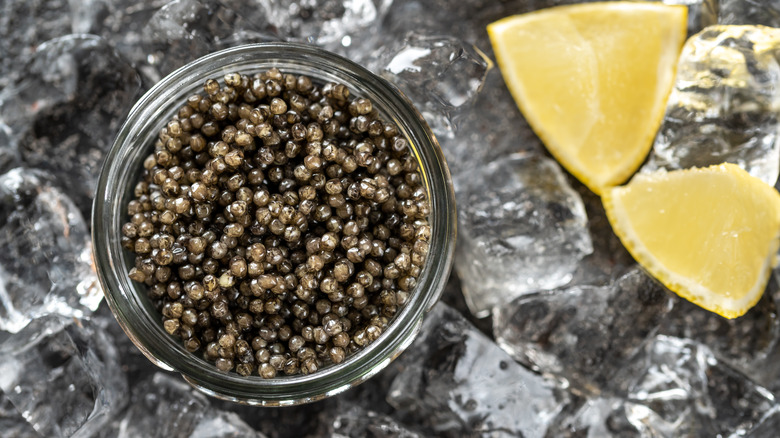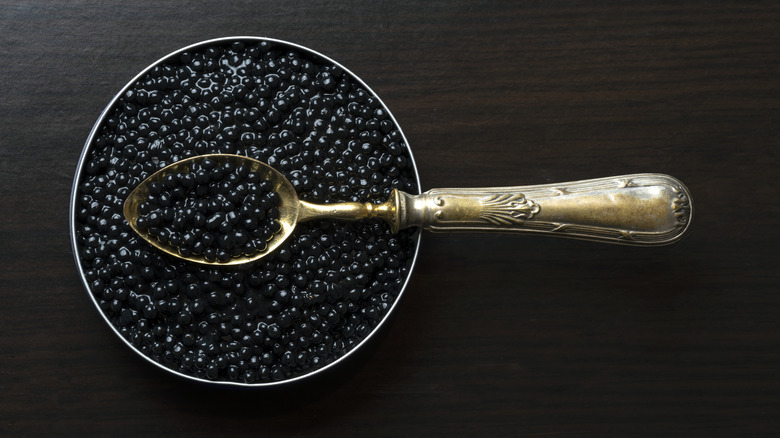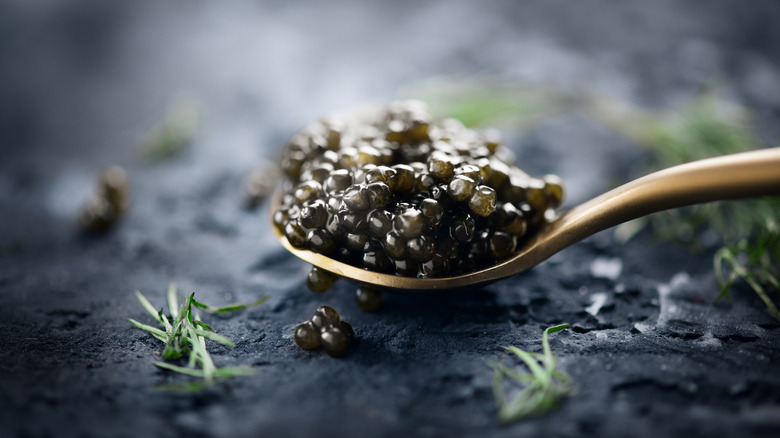Expert Explains The Differences Between All 7 Types Of Caviar
Caviar has become synonymous with luxury and yet, it's a greatly misunderstood delicacy. Caviar gets its name from the word khav-yar, used for "cake of strength," in Persia where these fish eggs were far from a delicacy reserved for the rich (via Arts & Collections). On the contrary, caviar was food eaten by fishermen out on the sea and as a salty snack that was freely served in American bars to coax its patrons into drinking more. It was only sometime after the Tsars of Russia had their first taste of the tiny eggs that caviar catapulted into the world of opulence.
The only unfertilized eggs that can be called caviar come from one of 27 species of sturgeon that are found mostly in the oceans of Asia, Europe, and North America. From each sturgeon comes a different variety of caviar with distinct characteristics of its own and the rarer a sturgeon is, the more expensive its caviar will be.
Although the rarity and expensive prices are what make varieties like beluga and osetra caviar most popular in the world of luxury, they aren't the only varieties of caviar that exist. Mashed spoke with Michelin Star Chef Donald Young, the owner of Chicago-based Duck Sel, to get the lowdown on seven types of caviar and what makes them so different from each other. Along the way, chef Young also told Mashed how to pair caviar, and surprisingly, not all caviar has to be accompanied by blinis, creme fraiche, and a mother-of-pearl spoon. Some varieties of caviar can even be paired with desserts!
American White Sturgeon
The Black Sea and the Caspian Sea have a reputation for being home to sturgeons that produce some of the world's finest caviar, but the American white sturgeon's eggs are thought to be rightfully at par in terms of their quality. Dubbed the American osetra after its pricer Russian counterpart, the American white sturgeon caviar is preferred by chefs for its versatility and relatively affordable price tag.
The white sturgeon is native to North America and can be found swimming in the waters between Alaska and Baja California. The black-colored eggs that the white sturgeon produces are fairly large in size and taste similar to the flavor that is expected from most other types of caviar which is a "light nutty flavor with hints of crisp seawater," says chef Young. This caviar has a buttery texture with a firm and smooth mouthfeel which it has in common with the sought-after osetra caviar, except the American white sturgeon tends to be a tad cheaper in comparison.
Sterlet
Sterlets are much smaller in size than other sturgeons and are typically found in the Caspian Sea between Europe and Asia. Sterlet sturgeon is currently on IUCN's Red List of Threatened Species along with most of its Caspian Sea cousins, but because sterlets tend to mature very quickly, they are one of the easier sturgeons to farm which is how the sterlet caviar is mostly produced these days.
The pearls of sterlet caviar range from light to dark grey and the delicate caviar has a mild flavor profile with buttery notes as well as a subtle sweetness. Sterlet caviar is fairly similar to sevruga in terms of its flavor, except the pearls are even smaller than the already tiny eggs that the sevruga sturgeon produces.
While sterlet caviar is usually a shade of grey, a type of sturgeon known as albino sterlet produces distinctly yellow-colored caviar. These bright, shiny, and golden-hued pearls have the soft and buttery texture of all sterlet caviar but with a light pop that releases a burst of juice when bit into.
Kaluga Hybrid
Kaluga sturgeons are a crossbreed of kaluga and Amur sturgeons which are both native to the Amur River in Asia. Unlike other sturgeons, kaluga is a predatory fish that is bigger in size than even beluga, making it the largest of all sturgeons. Kaluga and beluga sturgeons are often compared to each other as are the eggs they produce, which has given kaluga another name: river beluga.
Because the kaluga sturgeon itself is a unique fish compared to others, so is its caviar. Due to the sturgeon's size, kaluga caviar is also known for its large and firm pearls with a rich and refined taste that is not common in other types of caviar. The firm pearls, chef Young says, have a flavor that is "very buttery and earthy with some mild overtones of salt." Even its color is unique as kaluga hybrid caviar can range from gold to dark brown with some pearls even having an olive green hue to them.
Osetra
Osetra caviar comes from a bottom-feeder sturgeon, meaning it feeds near the bottom of the sea. The caviar that is produced depends very much on what the sturgeon feeds on, but, in general, osetra caviar is thought to be one of the finest types of caviar right alongside the famous beluga caviar. In fact, chef Young finds that it's the best caviar that you can get your hands on without spending a fortune.
The pearls of osetra caviar range from shades of deep brown to gold depending on what the sturgeons eat, but it's the caviar that's on the lighter end of the spectrum that's most sought-after. A rare type of osetra caviar known as golden osetra is particularly coveted for its rich, nutty, and creamy taste which bursts with the flavor of the sea that the sturgeons swim in.
If you do manage to snag a tin of the golden osetra caviar, chef Young recommends topping it on one-bite dishes to savor the wonderful flavor. For his own diners, the chef likes to serve golden osetra with a milk bread and p'tit basque grilled cheese sandwich which comes with A5 Miyazaki wagyu and a bone marrow sour cream and onion sauce. The nuttiness of golden osetra caviar offers a bold contrast to the wagyu beef and gives each bite of the dish an intense flavor.
Sevruga
Sevruga caviar is produced by a type of sturgeon known as starry or stellate sturgeon which is found in the vast waters of the Black, Azov, Caspian, and Aegean Seas in Eastern Europe. These sturgeons only grow till they weigh about 150lbs and measure 7 feet in length, which is a stark difference from the kaluga sturgeon. Because these sturgeons themselves are small, the pearls of sevruga caviar are also smaller and with a texture that's tender, but still pops when bitten into.
Sevruga caviar has the buttery flavor that's common in most types of caviar and its color ranges from grey to black. Sevruga also has minerality notes and a flavor that's saltier than other types of caviar. Despite the saltiness, however, the caviar feels clean and creamy on the tongue without the unsavory fishy taste that can be greatly off-putting. Because of its flavor profile and favorable price point, chef Young vouches for the fact that sevruga is "arguably the best-tasting caviar between osetra and beluga." Depending on which caviar you can get your hands on more easily, chef Young recommends serving sevruga or American white sturgeon caviar as a garnish with butter sauces over poached fish.
Beluga
For those not too familiar with the world of sturgeons and the differing types of fish eggs that they produce, beluga caviar is caviar — that's just how popular beluga caviar is. Beluga sturgeons are known to have been on the planet since the age of the dinosaurs, but recently, the sturgeons have become severely endangered. Beluga sturgeons have a lifespan of 100 years, which means it takes the sturgeons nearly two decades to start laying the first eggs. Because of this, beluga caviar nearly risked extinction and the U.S. imposed an import ban on the caviar in order to preserve the sturgeons. After 15 years, the ban was lifted in 2021.
Nevertheless, these sturgeons lay some of the largest and most delicate eggs that are a deep charcoal in color and sell for incredibly high prices. The Almas caviar, which comes from albino beluga sturgeons found near Iran, is one of the most expensive types of caviar in the world and a mere ounce of it can cost upwards of $34,000.
Siberian
Found in most major Siberian river basins as well as in Kazakhstan and China, Siberian caviar has a unique flavor profile which is what makes it chef Young's favorite type of caviar. At first glance, Siberian caviar has a glossy jet-black hue thanks to a large concentration of fats and oils, but a closer look reveals pearls that are actually shades of grey and green.
Unlike the signature pop that accompanies most caviar pearls, Siberian caviar tends to melt in the mouth instead. As they melt, the medium to small-sized pearls leave behind a taste that's neither too briny nor too salty, but instead, is reminiscent of nuts and the earthy, umami flavor of parmesan. Although chef Young likes golden osetra too, Siberian is his most preferred type of caviar.
Its cheesy flavor lends the caviar well to pasta, no doubt, but the chef prefers experimenting with the savory qualities of the caviar in a dessert. Before you shut down caviar-in-a-dessert as two things that should never belong together, chef Young explains that using the parmesan-like flavor of Siberian caviar in a dessert is akin to adding a pinch of salt to any dessert to bring out its sweetness. Caviar may be the epitome of luxury, but as chef Young's experiments show, it can certainly be fun to play with too.
